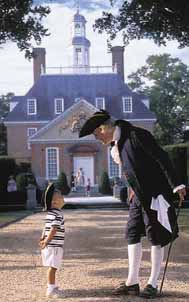Tar Heel
Travels
Visiting the Old Dominion
 In
July I wandered north to Virginia to visit
friends, play some golf, go sightseeing, relive a
bit of history and enjoy the culture and heritage
of the Old Dominion. The trip took me from
Wintergreen to Williamsburg, from the majestic
mountains in the west to the classic restored
colonial capital in the southeast. In
July I wandered north to Virginia to visit
friends, play some golf, go sightseeing, relive a
bit of history and enjoy the culture and heritage
of the Old Dominion. The trip took me from
Wintergreen to Williamsburg, from the majestic
mountains in the west to the classic restored
colonial capital in the southeast.
Wintergreen, a
10,000-acre resort and residential area that sits
high in the Blue Ridge Mountains, is one of the
South's premier skiing areas. In the summer it's
a scenic hub for a variety of outdoor activities
that include golf, tennis, hiking, cycling,
fishing, boating and horseback riding.
The Blue Ridge Parkway
is less than a mile from Wintergreen's main
entrance, offering fabulous panoramic views of
the lush, fertile Shenandoah Valley below.
Charlottesville, Staunton and Lexington are
must-visit towns that are nearby.
The valley was unusually
warm because of the heat wave, but cool breezes
wafted through the ridges dotted with attractive
homes and condos hidden among the trees. Visitors
at the mountain-top resort and other guests were
going in and out of a number of fine shops or
dining at The Copper Mine restaurant.
The late Ellis Maples of
Pinehurst designed Devils Knob, Wintergreen's
first golf course, and created a jewel in the
process. Scenic and challenging, the course
traverses through a heavily forested route until
it reaches the mountain top, offering spectacular
views along the way.
Down in the valley, in
the shadow of the mountain range, Rees Jones
designed Stoney Creek, a 27-hole layout that
ranks as one of Virginia's best courses. Like a
trophy wife, the course is beautiful but
demanding, and it can't be taken for granted.
Both courses are thoroughly enjoyable.
Leaving Wintergreen, we
drove to Charlottesville in a trip that's all too
short as the scenery increases in beauty with
every mile. The rolling hills, white fences, open
pastures, handsome horses and stately mansions
evoke memories of Thomas Jefferson, James
Madison, Lady Astor and the many colorful figures
in Virginia's proud past.
A walking tour of the
University of Virginia campus, as charming and
dignified as any you will ever see, strengthens
the nostalgia of the Jefferson era. Like his
beloved Monticello, a short drive from campus,
the university was a creation he prized.
From Charlottesville to
Williamsburg is a casual, relaxing and
picturesque trip on Interstate 64 that takes less
than two hours. Devoid of any commercial
development, this route is perhaps the prettiest
of any interstate highway. Travelers may detour
through Richmond if a visit to that great city is
on the agenda.
It's always a thrill to
visit Colonial Williamsburg, even through my
association goes back to World War II when I went
through boot camp at Camp Peary, a stone's throw
from the historic town that was authentically
restored by John D. Rockefeller in 1932. Camp
Peary, incidentally, is still in existence
although now it's a hush-hush CIA facility
off-limits to visitors.
My visits and leisurely
strolls around the 130-acre Williamsburg complex
usually center around the same things the many
visitors do: marvel at the classic homes and
buildings; visit the Governor's Palace, the
Bruton Parish Church, the three museums, walk
along Duke of Gloucester Street and know that
George Washington, Patrick Henry and Thomas
Jefferson were there before me.
And if I thought the
University of Virginia reeked with history, my
walks through the William and Mary campus, which
dates to 1693, are even more reminiscent of our
17th and 18th century heritage.
Fine dining awaits at
Chowning's or Christiana Campbell's and there are
fascinating side trips to Carter's Grove and
Yorktown. Finding interesting things to see and
do is not a problem in Colonial Williamsburg.
But this visit was to
accomplish two things: experience a stay at the
renowned Williamsburg Inn, one of the nation's
finest hostelries, and to play golf at the Golden
Horseshoe, which also ranks with the best in the
country.
The Williamsburg Inn is
a luxurious four-star, four-diamond hotel that
represents the best in hospitality,
accommodations, food and service.
The rooms are large and
comfortable, tastefully decorated and
well-attended by maids and room service
personnel, and cuisine in the elegant Regency
Dining Room is a gourmet experience too
delightful for a layman to describe.
Handsome and dignified,
the inn opened in 1937 and has housed numerous
celebrities, including Winston Churchill,
President Eisenhower, President Reagan, Margaret
Thatcher, Bill Cosby, Tom Selleck and countless
others.
Adjoining the inn is the
Gold Course, which architect Robert Trent Jones
says is his finest, and I won't argue. It is a
truly outstanding golf course with rare beauty
and 18 varied challenges for players of all
caliber. It opened for play in 1963.
Alongside Jones'
masterpiece, which went through an extensive
renovation program in 1998, is the Green course,
designed by his son, Rees Jones, and a great
addition to the Williamsburg facilities. There is
also a nine-hole executive course, the Spotswood,
a sporty layout that plays to a par of 31.
History, golf, fine
dining, great accommodations. It's all in
Williamsburg, a travel destination that ranks in
everyone's ten.
|

